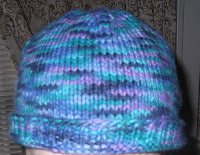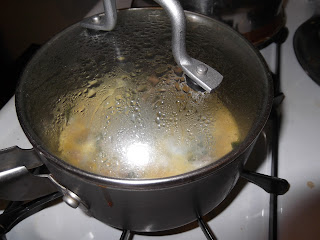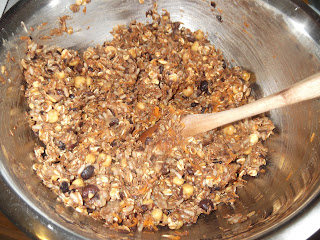The comfort hat delivered, I still had some Caron Soft paints in Oceana left. It was sitting there on my desk staring at me when I remembered why I originally purchased that particular skein of yarn. It was a Christmas present two years ago. I had just purchased
Amigurumi Knits by Hansi Singh and I did not yet have a yarn stash at all if you can believe it. As you may recall, I used the first section of this book, which provides patterns for
knitted vegetables, to learn knitting amigurumi and gave them to my nephew for a birthday present.
The yarn for those vegetables, and for all the other amigurumi in Singh's book where purchased for me by my husband. Essentially, I walked through the worsted weight yarn area at the local Joanne's and grabbed a skein for each color I would need. The bulk of my accumulated acrylic worsted weight stash comes from this venture. Oceana was meant to be the top color of a star fish (somewhat lackluster comparted to the other patterns in the book), but more importantly, for the shells of both the hermit crab and the garden snail. Of course, after I finished the veggies in the book, I needed a long break from amigurumi and its fiddly nature, the stash accumulated, and the reasons for why I bought certain skeins of it got a bit muddled.
Figure One
The leftovers from the skein I used on the hat seemed enough to make both shells. At the very least, I thought I'd start in on the garden snail shell and see what was left at the end.
(In case you were wondering how snail won over crab, snails play a fairly important role in the plot of my first novel, completely inadvertently. I now inherently steer toward snails. They are creatures connected to my creative energy come to fruition.)
Figure Two
Over the course of a few days, I took that leftover yarn and I made a snail shell. It required much short rowing and a fair amount of dexterity to get at those stitches near the tail end of the shell (the ones nearest the tip of the spiral.
Essentially, you make a narrowing strip of knitting (pictured in what I've fondly labeled "Figure One"). Then you pick up stitches at the cast on edge and create a mirror image of the first strip so that their cast on edges meet in the middle, like a butterfly's wings. Then, you graft the live stitches from the first strip to the live stitches of the second strip with the knit side facing out, as in what I have fondly labeled "Figure Two."
By the end of the madness, you have magically created a spiraling snail shell. It's tedious and time consuming and potentially tear-inducing, but man, does it look nifty.
Next up on the snail agenda is the slug-like body, which the shell will ultimately be sewn into. There is some confusion on the hansigurumi group discussion board on ravelry as to how to go about creating this body, called a "foot" scientifically and a "mantle" in the pattern.The consensus, however, is that it's not easy and some reading and interpreting of errata is involved.
In the interum, I'm about to move forward on the stained glass michigan blanket by swatching the yarn for gauge and creating the necessary charts. I hope to have a solid plan in place by Christmas.
And speaking of Christmas, I nearly forgot about my son's teacher needing a proper present. I considered repeating the gift of an apple sock to protect her fruit en route to school, but then I remembered the mother bear project has sponsorships. I donated the sponsorhsip of a bear to my son's teacher by going here:
http://www.motherbearproject.org/sponsor_bears.html and hitting the donate button. They have it all linked up with paypal and make it very simple. Then, I emailed the project to let them know who I was sponsoring and what her contact info was (name, address, reason for donation, person donating on their behalf). They send a lovely card to the recipient of the sponsorship and name one of the unclaimed mother bear's in the recipient's honor. That bear then gets sent to Africa (or other continent/location where children go without) and given to a child whose life has been affected by AIDS, abandonment, tragedy, disease, orphanages, or all of the above. What's more, Africa sends back a picture of the child happily holding their new bear companion.
I can't think of a better gift for a teacher (who usually really don't want another cute piece of #1 teacher paraphernalia) than the knowledge that he or she has aided in bringing a smile and a sense of love and comfort to a child with very few reasons to smile. If you don't donate for a teacher, donate for yourself or a relative. If you know how to knit and crochet, you can also purchase a pattern to make a bear yourself for the project to send to Africa. Two of my favorite podcasts,
Cogknitive and the
2 Knit Lit Chicks, each run an annual knit/crochet-a-long to inspire bear creation. I plan on participating this year, and the next one runs from January to February. I'm sure I'll talk more about mother bears then too, but in the spirit of the holidays and the season of giving, I wanted to mention it now. Teachers are hard to buy for and it's such a worthy cause.



























